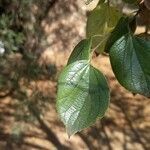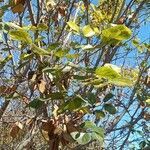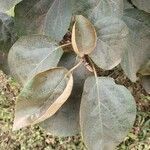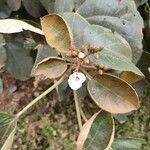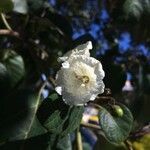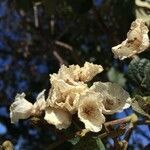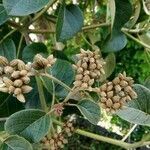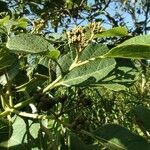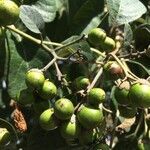A large tree. It looses its leaves during the year. The crown is rounded. The trunk is often crooked. It grows 15 m high. The bark is pale brown and rough. It becomes cracked with age. The leaves are large and oval. They can be 16 cm long. They taper towards the tip. The base is rounded. The leaves are dark green above and paler underneath. The young shoots and underneath the leaves are covered with soft brown hairs. The flowers are white. They are funnel shaped. The occur in large numbers near the ends of branches. The flowers have a sweet scent. The fruit are round and 1 cm across. They are yellow. They are in a hairy cup. The seeds are in sweet sticky flesh. The fruit is edible. They contain about 6 seeds.
Leaves alternate or sometimes almost ternate; petiole (1.5)2.5–10.5 cm. long, canaliculate, glabrous or tawny-powdery and sometimes also tawny-pubescent; lamina 6–21 x 4.0–16.5 cm., ovate or broadly ovate, sometimes subcircular or elliptic, glabrous or on the youngest leaves scabrous or minutely scaly above, powdery and often tawny-hairy on the nerves and veins below, usually rounded and suddenly shortly acuminate, sometimes acute at the apex, subacute to cordate and often asymmetrical at the base, with entire or shallowly crenate margins, usually stiffly coriaceous, with 5–7 secondary nerves on each side of the midrib, tertiary nerves perpendicular to the secondary ones, both prominent below.
Small to medium sized deciduous tree, up to 24 m. high; trunk usually forking a few meters from the base; bark grey to dark brown, shallow fissured; crown spreading, dome-shaped; branchlets glabrous, powdery or pubescent, sometimes hairy.
Calyx 7–9 mm. long and 4–7 mm. wide at the mouth, tubular, with 10–12 well marked ridges, coriaceous, minutely tomentose outside, glabrous inside, opening by an operculum and later splitting into 3–5 teeth, sometimes becoming bilabiate.
Small to medium-sized tree, up to 24 m high. Leaves farinose below, with or without spreading hairs. Calyx in flower with 10-12 well-marked ridges, tomentose outside. Corolla lobes shallow, much broader than long. Flowers white.
Fruit c. 12 x 8 mm., ovoid, ellipsoid or obovoid, apiculate, glabrous, dark brown, surrounded at base by the widened cup-shaped calyx; pyrene subquadrangular in cross section.
Corolla 17–21(24) mm. long, funnel-shaped, white; tube 15–19(22) mm. long; lobes 1.5–3.0 x 10–13(15) mm., retuse and with a pubescent mucron c. 1 mm. long, margin undulate.
Stamens enclosed, inserted at 3–5 mm. from the base of the corolla; anthers 2.0–2.5 mm. long; filaments 7–10 mm. long, slender, with a few pellucid hairs at the base.
Ovary c. 2.0 x 1.5 mm., ovoid, glabrous; style 13–18 mm. long, first forked at 7–12 mm. from the base, stigmatic branches c. 1.5 mm. long, more or less clavate.
Cymes arranged in terminal leafy usually ample panicles; rhachis and branches tawny or brown, minutely tomentose.
Conspicuous funnel-shaped white flowers in paniculate cymes
Flowers hermaphrodite, on pedicels up to 1 mm. long.
Yellow succulent fruits 1/3-1/2 in. in diam.
A shrub or small tree up to 25 ft. high
Broad leaves strongly-nerved beneath
Seeds 1–2, very rarely 3–4.
Often planted.
